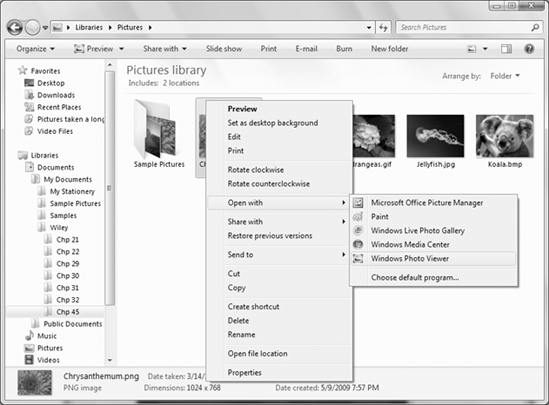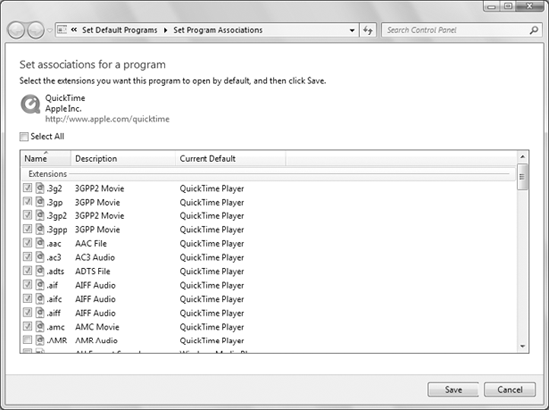Typed text, pictures, music files, and video
clips are all examples of documents and other types of files that you
can create or download to your computer. There are thousands of
different file types. Each type is indicated by its filename extension.
For example, a picture might be a JPEG (.jpeg or .jpg), bitmap (.bmp),
GIF (.gif), TIFF (.tif or .TIFF), Portable Network Graphics (.PNG), or
any of a couple dozen other formats.
When you click (or double-click) a file icon, the file opens in whatever is the default program
for its type. If you have more than one program that can open the file
type, you can override the default and open the file with some other
program. Right-click the file's icon and choose Open With as in Figure 1. The Open With option will be available only if you have two or more programs installed that can open that type of file.
If you want to keep the current default program for
this type of file, and override that just this time, click the name of
the program you want to use to open the file.

If you want to change the default program that
Windows always uses to open that type of file, click Choose Default
Program at the bottom of the Open With menu. The Open With dialog box
shown in Figure 2 opens.
|
If Windows is configured to hide filename extensions,
you won't see them in your Pictures folder or other folders. But you
can point to a file icon and see the filename extension in the tooltip
that appears at the mouse pointer. Optionally, you can make filename
extensions visible by clearing the checkmark next to Hide Extensions for
Known File Types in Folder Options. You can open the Folder Options
dialog box from the Organize button in any folder (click Folder and
Search Options). Or open Control Panel, choose Appearance and
Personalization, and then choose Folder Options. In the Folder Options
dialog box, click the View tab and scroll down to the Hide Extensions
option.
|
Click whatever program you want to use for opening
that type of document. Also, make sure the Always Use the Selected
Program to Open This Kind of File option is selected (checked).
Otherwise your new choice won't be saved.

If you can't find the program you want to use as the
default, you can click the Browse button to look for it. Just make sure
that the program you want to use is capable of opening that type of
document.
Setting default programs using the Open With dialog
box is just one way to do it. Many programs have options within them
that let you choose which file types you want to associate with the
program. The settings within the program might even override the
settings you specify in Windows. So sometimes you have to go into the
program that's acting as the default for a file type, and make a change
there.
Unfortunately, there's no one-rule-fits-all for the
hundreds of programs that allow you to change associations within a
program. Typically you start by opening the program and choosing Tools => Options or Edit =>
Preferences or something like that, to get to the program's main
options. To illustrate, I'll use QuickTime (Version 7) as an example,
because many people have that program.
In QuickTime, you first open the QuickTime player from the All Programs menu. Then choose Edit => Preferences =>
QuickTime Preferences from its menu bar. Click the Browser tab, click
File Types, and you're taken to a dialog box where you can specify file
types that should open automatically in QuickTime. Select (check) the
file types you do want to open in QuickTime automatically. Clear the
checkmarks for those file types for which QuickTime should not act as
the default program. Figure 43-3 shows an example.
Of course, there's no right or wrong program to
associate with a given file type. The choice is up to you. You just have
to make sure to always specify a program that can
open files of a given type. For example, it wouldn't make sense to
associate video or audio files with Microsoft Word or Excel, because
those programs don't play multimedia files.
